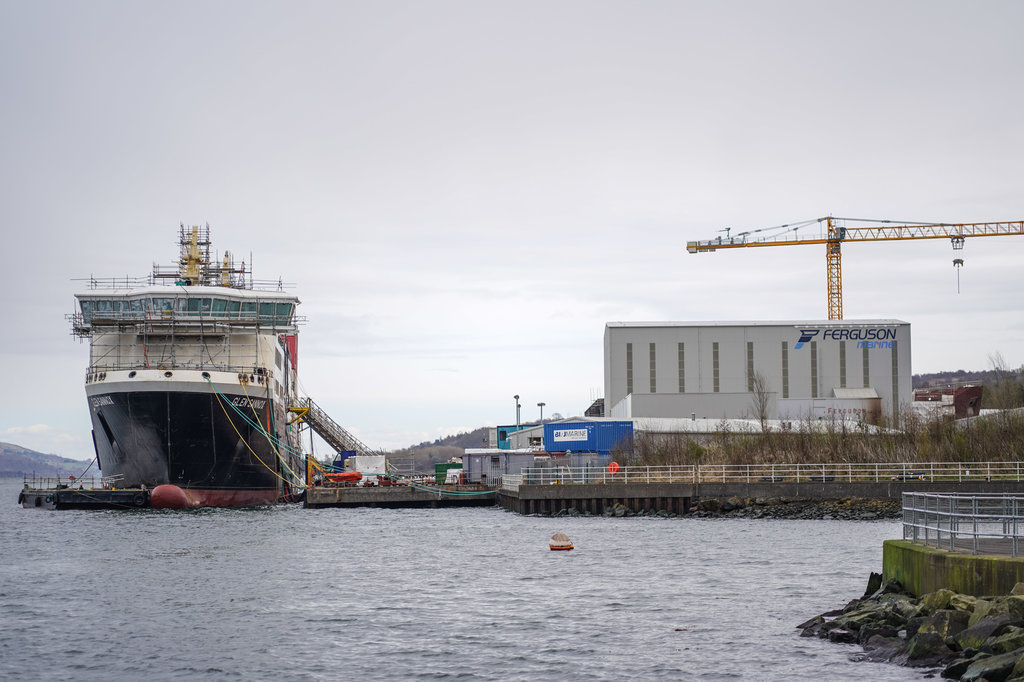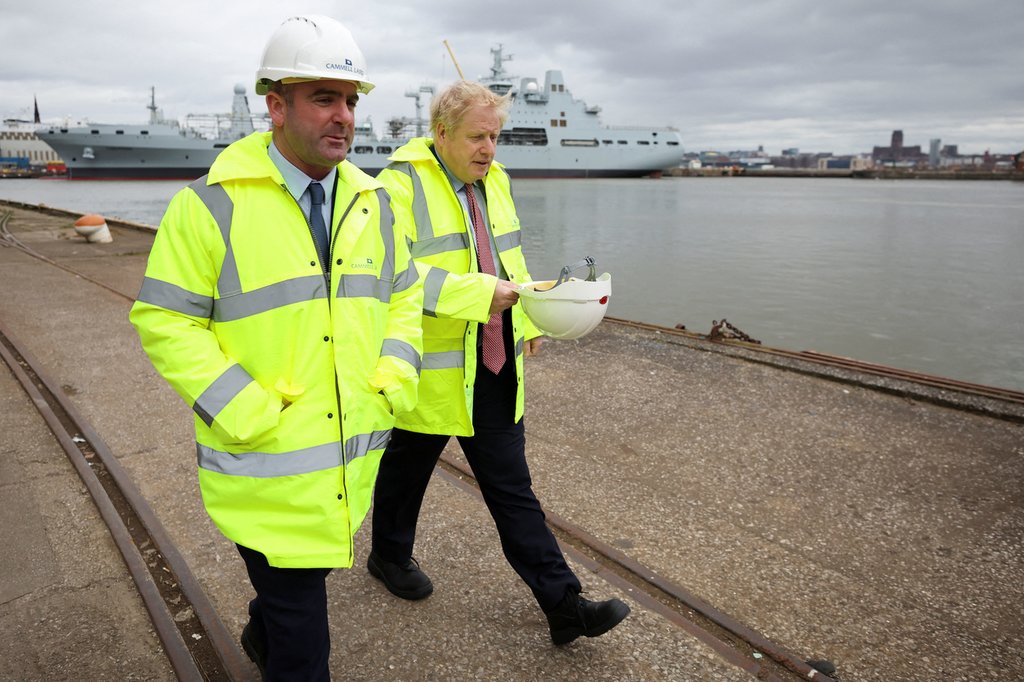Shipbuilding
Are UK shipyards prepared to invest in the future?
The UK shipbuilding industry has been urged to prove its competitiveness with inward investment, as Richard Thomas reports.
Image: copyright
Shipyards in the UK should look to invest in their own facilities in order to give themselves the best opportunity to secure government contracts, as well as increasing their competitivity on the international space, according to Shipbuilding Tsar and UK Secretary of State for Defence, Ben Wallace.
For decades, UK shipyards had faced a gradual decline in workshare, as a numerically shrinking Royal Navy and increased competition from European and other global facilities brought challenges that pushed many businesses to the brink. The National Shipbuilding Strategy, written by Sir John Parker and first published in 2016 and subsequently updated, offers potential solutions to revitalise the UK’s shipbuilding sector.
UK Defence Secretary Ben Wallace, appointed Shipbuilding Tsar in 2019, told the UK Defence Committee during a 5 July session that UK shipyards, both those focused towards military or commercial alike, had to invest in their own facilities in order to increase capacity, efficiencies and competitiveness.
“Some yards are ready for the future, and some aren’t,” said Wallace.
The frigate factories
In December last year, defence prime Babcock revealed the completion of its new warship assembly hall at its Rosyth site in Scotland, which included two 125t gantry cranes. The new facility will initially be used for the assembly of the Royal Navy’s Type 31 frigates, a class of general-purpose warships that will replace five of the 13 current Type 23 platforms, most of which entered service in the 1990s.
According to the Babcock at the announcement of the frigate hall completion, the company would recruit 500 workers for its Type 31 frigate programme, including welders, fabricators, and mechanical and electrical fitters, as well as production support employees.
The site could also benefit from future orders of the type in the international market, with the Type 31 design, itself based on the Danish Iver Huitfeldt class, also being selected by Indonesia for its own respective national requirement and in the running for programmes in Poland and Greece.
Babcock’s main rival in UK naval shipbuilding is BAE Systems, which is building the Type 26 anti-submarine warfare frigates at its sites at Govan and Scotstoun in Glasgow. Unlike Babock, the sites lack the ability to completely manufacture a frigate-sized warship inside a build hall, with blocks instead built inside and then moved to exterior hard standing on the dockyard for assembly.
BAE Systems had earlier made plans to create such a facility, Wallace said, however the company was at the time unable to agree the process with the Ministry of Defence (MoD). More recently, it has emerged that BAE Systems will create such a manufacturing capability, often dubbed the ‘frigate factory’.
“The Babcock leadership came along, invested in the build hall, and got on with it. BAE, who are now doing it, first of all wanted us to pay for it,” Wallace said. “I’m delighted BAE is going to be putting a covered build hall in place. We will be contributing to it, as the MoD and the customer, but that is the sort of thing that is about the cultural shift and investing in the yards.”

Ferguson Marine shipyard in Port Glasgow, Scotland. While building two Ferries on contract for Calmac, Scottish ferry company Ferguson Marine Engineering was put into administration as costs spiralled and building was delayed. Credit: Peter Summers/Getty Images
Inwards investment
Sites UK such as Harland & Wolff (Belfast) and Harland and Wolff (Appledore) have also invested in recent years in their respective sites in Northern Ireland and the southwest of the England, refurbishing drydock facilities and regenerating the local workforce, which had reduced or lost much of the skills needed for complex ship manufacture and maintenance.
The Belfast site has pledged a mix of commercial and naval contracts would be sought to sustain the business in the long term, and recently won deal for cruise ship maintenance and sustainment.
Wallace described the Harland & Wolff investments as being “really positive”, with the company “active and bidding in a number of contracts” and was “in a good place” for future successes.
Other sites such as Pendennis Shipyard in Falmouth had also invested recently in infrastructure, in order to boost capacity. “Pendennis bought new lift – investing in the capital of the yard can make a real difference. Some are happy with that, some are comfortable, some don’t want to do it at all,” Wallace said.
The UK was also encouraging outward investment from European companies into UK yards, in a bid to learn best business practices and key industry skills.
It is thought that potential foreign investment into UK sites could be a factor in naval programmes such as the much-delayed Future Solid Support (FSS) ship, which will deliver three logistics platforms to the Royal Fleet Auxiliary, and long-thought likely to be manufactured overseas.
If a British bid said it wasn’t going to invest in yards, or a foreign bid said it would invest in British yards, which would you select?
In such an eventuality, the foreign shipyard would be required to invest a proportion of the value of the contract back into UK commercial or military shipbuilding.
“I had one defence prime ask me to lobby to bring in a whole load of workforce from aboard at mass, and I said no, but I would support bringing in, in the number of tens, ten or 20, instructors or people who could teach our British citizens how to be the welders of the future,” Wallace said of overseas investment in UK shipbuilding capacity.
When asked about the prospect for a UK naval vessel, albeit not a ship-of-the-line, being manufacturing overseas (as was done with the Tide-class replenishment tankers currently in service), Wallace said that “majority” of any such programme would be performed in the UK, either as build or systems integration.
“If a British bid said it wasn’t going to invest in yards, or a foreign bid said it would invest in British yards, which would you select?” Wallace stated.
The imperative for Wallace is to create the environment in which UK shipyards could compete into the future remains firm. Much of the onus would sit with industry however, and its willingness to invest in developing new capabilities.
“[The] instinct in some of the primes is to keep going at the similar pace and bank the order book but not double their production line. We have got to make sure we push them hard in investing in their own production lines,” Wallace said.
“I can only do so much. We’re not going to nationalise these production lines, some of the primes have spent a lot of their money buying back their own shares rather than investing in the manufacturing base.”
Timeline concerns
Despite the positive developments in naval warship manufacturing and the ongoing production of the first of eight Type 26 frigates and five Type 31 frigates that will replace the ageing Type 23 Duke class, production delays still threaten delivery timelines.
The first in class of the Type 26’s, the future HMS Glasgow, is currently 12 months behind schedule and will now only reach initial operating capability by 2028. Specific issues that led to the delays included the engineering maturity of the type 26 design as well as supply chain performance, possibly linked to the vessel’s gearbox, the committee heard.
Meanwhile, the first in class of the Type 31 frigates, the future HMS Venturer, is still in the early stages of manufacture and not expected to be delivered before 2027. The first of the Type 23 frigates, HMS Monmouth, initially intended to be removed from service between 2023 and 2035, was retired in the summer of 2021, with a second, HMS Montrose, potentially to be decommissioned in the summer of 2023.
According to a Parliamentary Written Response in April 2022, there were no plans to delay the out-of-service dates of the Type 23 class. An earlier government schedule for the retirement of the type, can be seen in the table below.
Given the schedule of outgoing and expecting incoming vessels, the Royal Navy will dip below the 19 surface warships stated as being necessary for the continued fulfilment of its standing duties, although improved availability of the remaining vessels is hoped to counteract some of the hull losses.
Future projects
Other key naval shipbuilding programmes include the earlier-mentioned Future Solid Support Ship, intended to replace the Fort-class replenishment ships, only one of which, Fort Victoria, is still in service. However, an earlier international tender was cancelled in 2019, with a decision now on the £1.617bn ($1.94bn) for the manufacture of three vessels expected by the end of Q1 2023.
The planned manufacture and delivery schedule of the FSS vessels means RFA Fort Victoria, commissioned in 1994, will now be decommissioned in 2028 after 34 years of service. All three of the FSS vessels are due to be delivered by 2032.
Elsewhere, the replacement of the amphibious assault ships HMS Bulwark and HMS Albion is not expected until at least 2030, with the UK joining an international partner to share a common design.
The planned Type 32 and Type 83, the former likely expected to host a range of mine countermeasure and other autonomous systems, the latter in replacement of the Type 45 air defence destroyers, are expected to move from the concept phase by around the late-2020s to deliver platforms from the mid-2030s.

British Prime Minister Boris Johnson (R) walks with Cammell Laird managing director Mike Hill (L) at the Cammell Laird shipyard in Merseyside on 10 March 2022. Credit: Phil Noble/Pool/AFP/Getty Images
Meanwhile, the service life of HMS Argus, which dates from the 1980s, has been extended in order to maintain the UK’s Role 3 naval medical capability.
It also emerged that the UK could again seek to acquire an interim anti-ship missile capability for its surface warships in order to maintain anti-ship capabilities when the older Harpoon systems are retired in 2023. The programme had been left out of the 2021 Defence Command Paper, however, Wallace told the committee that the Royal Navy was currently in negotiations with industry to purchase a replacement system.
The interim anti-ship missile is intended to fill the gap between the retirement of Harpoon and the Future Cruise/Anti–Ship Weapon being developed by the UK and France. It is not known whether such an interim system would be canister launched, as the current Harpoon systems is, or deployed from the Mk 41 vertical launch system being fitted to the Type 26 frigates, and potentially the Type 31 class at a later date.